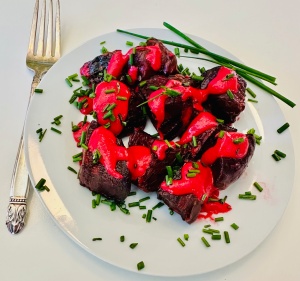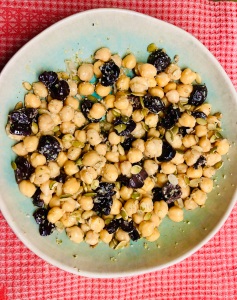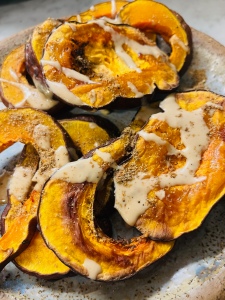Instead of a shank bone, many people now replace it with a roasted beet on their seder plate (z’roa) as a representation of the pascal lamb, for a veg based meal. Inspired by this custom, I decided to prepare a roasted beet dish. I used red beets but you could use golden or an assortment. I love the versatility of beets-raw, roasted, liquified, and more. This one is a combination of roasted beets as well as tahini with roasted beets. Added bonus are the chives I clipped from my sister’s garden to sprinkle on top. Scroll below for the recipe plus my other previous Pesach recipes including karpras salad and olive oil chocolate cake. And, click here to learn about leaving an empty seat at your seder table for a hostage. Continue reading
Category Archives: Side dish
Purim: Queen Esther’s Salad
You might be wondering where the hamantaschen recipe is (scroll to the bottom) or why I’m sharing a bean recipe for Purim. The Queen Esther salad that I created is for a Purim seudah (meal) and is made with many symbolic ingredients. First, according to Gil Marks in Olives and Honey Trees, chickpeas are a traditional Ashkenazi food eaten at Purim (amongst other celebrations). Olives are a symbol of mourning and also commonly eaten in Purim dishes that symbolized Haman (along with eggs and other ingredients like noodles), as explained in Claudia Roden’s, The Book of Jewish Food. Last, there’s a Talmudic teaching that Queen Esther became a vegan, eating just legumes and seeds while she lived in King Achashaverus palace, to ensure she did not eat non kosher foods (another bonus of being vegan :)). I generally sprinkle seeds on my salad, because I like the crunchy texture and contrasting flavors they provide. And, if you’re looking for more delicious (and sweet) Purim recipes, they are at the bottom of the post (including two types of hamantaschen)! Continue reading
Sukkot Couscous & Fall Vegetables
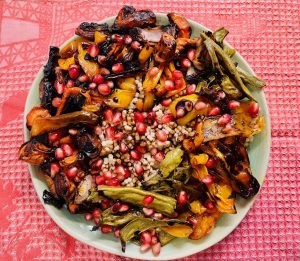 I love Sukkot–eating outside, enjoying fall fruits and vegetables, deepening our connections with nature and agricultural cycles. I recently spent time at an incredible native plants nursery near my home. It was fantastic: endless rows of plants native to the Mid-Atlantic region with detailed signs explaining the type of soil and sun they prefer. Between the rows the ground was deep mud and water after heavy rains for two days. Trudging along the rows in my rain boots, I just wanted to buy everything! The native plants are essential because they are “native” to the region in which they evolved and planting them helps to support biodiversity that attracts pollinators such as bees as well as butterflies and birds, better absorbs groundwater retention, and doesn’t require the use of chemicals. Perhaps native plants don’t look as neat and trim as other gardens but they are humming, buzzing and flourishing. The Sukkot dish I made reinforces the importance of local, sustainable agriculture and happens to be easy and delicious. Continue reading
I love Sukkot–eating outside, enjoying fall fruits and vegetables, deepening our connections with nature and agricultural cycles. I recently spent time at an incredible native plants nursery near my home. It was fantastic: endless rows of plants native to the Mid-Atlantic region with detailed signs explaining the type of soil and sun they prefer. Between the rows the ground was deep mud and water after heavy rains for two days. Trudging along the rows in my rain boots, I just wanted to buy everything! The native plants are essential because they are “native” to the region in which they evolved and planting them helps to support biodiversity that attracts pollinators such as bees as well as butterflies and birds, better absorbs groundwater retention, and doesn’t require the use of chemicals. Perhaps native plants don’t look as neat and trim as other gardens but they are humming, buzzing and flourishing. The Sukkot dish I made reinforces the importance of local, sustainable agriculture and happens to be easy and delicious. Continue reading
Rosh Hashana: Black Eyed Peas
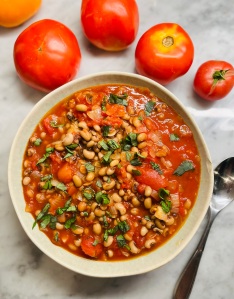 I recently read Michael Twitty’s latest fabulous book, Koshersoul, a personal and culinary exploration as a Black Jewish man. Beautifully written with lots of recipes that trace the intersections and influences of African foods, African-American cuisine, Jewish Southern dishes, and Sephardic foods. One ingredient he wrote about was black eyed peas, commonly found in African, African-American and Sephardic and Mizrachi dishes. Black eyed peas are commonly eaten at Rosh Hashana as a symbol of a prosperous new year. Continue reading
I recently read Michael Twitty’s latest fabulous book, Koshersoul, a personal and culinary exploration as a Black Jewish man. Beautifully written with lots of recipes that trace the intersections and influences of African foods, African-American cuisine, Jewish Southern dishes, and Sephardic foods. One ingredient he wrote about was black eyed peas, commonly found in African, African-American and Sephardic and Mizrachi dishes. Black eyed peas are commonly eaten at Rosh Hashana as a symbol of a prosperous new year. Continue reading
Antwerp & Roasted Pumpkin
I spent the first day of 2023 in Antwerp, a city with one of the largest Chasidic populations in Europe. A famous kosher restaurant, Hoffy’s, was open and we excitedly arrived for lunch. We were told to come back in about an hour when they were ready. We walked around the neighborhood (which abuts the city’s diamond district). The area was empty–besides Hoffy’s and a kosher market and a quick stop into the Portuguese synagogue, nothing was open and few people were out. We returned to Hoffy’s which was filled with strong aromas wafting from the kitchen while staff hurriedly ran around getting the dining area ready, placing small flower vases and candles on tables while waiters quickly wrapped aprons around their waists. Continue reading
Sukkot & Simchat Torah: Stuffed eggplants
 Just a quick post to share a stuffed eggplant recipe that is great for both Sukkot and Simchat Torah. Sukkot, an agricultural holiday (ie farm-to-table holiday) that is an opportunity to use the produce that is in abundance at the farmers markets right now makes it one of my favorite holidays. Lots of eggplants are in season at my local farmers markets and the basil was plucked straight from my plants. The filled eggplants are also symbolic of “stuffed” foods commonly eaten on Simchat Torah to represent the Torah scrolls. Scroll to the bottom for more of my Sukkot, Simchat Torah and even Shmini Atzeret recipes. Chag sameach! Continue reading
Just a quick post to share a stuffed eggplant recipe that is great for both Sukkot and Simchat Torah. Sukkot, an agricultural holiday (ie farm-to-table holiday) that is an opportunity to use the produce that is in abundance at the farmers markets right now makes it one of my favorite holidays. Lots of eggplants are in season at my local farmers markets and the basil was plucked straight from my plants. The filled eggplants are also symbolic of “stuffed” foods commonly eaten on Simchat Torah to represent the Torah scrolls. Scroll to the bottom for more of my Sukkot, Simchat Torah and even Shmini Atzeret recipes. Chag sameach! Continue reading
Rosh Hashana: Beet Carpaccio
 I love this beet carpaccio recipe! I first enjoyed it at a serene Shabbat dinner at my relative’s house during a glorious pre-Covid spring in Jerusalem. The flavors of the roasted beets are enough alone but topped with a lot of delicious ingredients that delicately balance both tangy and sweet flavors makes the beets the star of a rich, dramatic dish. It’s also a “one pan” dish that is simple to make. It’s perfect as an appetizer or side dish during a Rosh Hashana meal. Also, check the links below the recipe for more of my sweet and savory Rosh Hashana recipes. Shana tova! Continue reading
I love this beet carpaccio recipe! I first enjoyed it at a serene Shabbat dinner at my relative’s house during a glorious pre-Covid spring in Jerusalem. The flavors of the roasted beets are enough alone but topped with a lot of delicious ingredients that delicately balance both tangy and sweet flavors makes the beets the star of a rich, dramatic dish. It’s also a “one pan” dish that is simple to make. It’s perfect as an appetizer or side dish during a Rosh Hashana meal. Also, check the links below the recipe for more of my sweet and savory Rosh Hashana recipes. Shana tova! Continue reading
Spring Foraging for Berries
While last spring was remarkable because the world had shut down, spring this year is remarkable as parts of the world start to slowly re-emerge. It was a collective, tragic, exhausting hibernation the past 16 months. When things dramatically stopped last year, my senses became more acute to the subtle, beautiful things in my life, such as wild flowers sprouting from sidewalk cracks, the remarkable shades of green leaves in the forest behind my home, and the symphony of birds that awoke me early every morning.
The covid winter was challenging in many ways but I was very fortunate to always be in good health. On the food front, I became uninspired in my daily cooking and my diet devolved into mainly smoothies, popcorn, and salads. My sole cooking inspiration was to bake breads and cakes for friends and family and the ingredients that were exciting were the ones that I foraged.
Fall Foraging: Mushrooms
 I have had the great opportunity to trample through the woods and fields just outside Rock Creek National Park to forage for edible plants, berries, flowers and mushrooms this fall. Foraging aside, I have spent endless hours during Covid inside Rock Creek park. I joke that it is my second home but it really is: I don’t start any morning now without hiking or biking in it, no matter the weather, and end many days with a quick jaunt on trails. Spending so much time in Rock Creek has made me keenly aware of the subtle changes every day to the spectacular landscape from the multitude of distinct shades of green leaves in early spring to the trails disappearing afoot as they become layered with leaf cover in the fall. And, my connection to the land has deepened as I have learned about the myriad edible plants and mushrooms living in it.
I have had the great opportunity to trample through the woods and fields just outside Rock Creek National Park to forage for edible plants, berries, flowers and mushrooms this fall. Foraging aside, I have spent endless hours during Covid inside Rock Creek park. I joke that it is my second home but it really is: I don’t start any morning now without hiking or biking in it, no matter the weather, and end many days with a quick jaunt on trails. Spending so much time in Rock Creek has made me keenly aware of the subtle changes every day to the spectacular landscape from the multitude of distinct shades of green leaves in early spring to the trails disappearing afoot as they become layered with leaf cover in the fall. And, my connection to the land has deepened as I have learned about the myriad edible plants and mushrooms living in it.
Sukkot: Roasted Apples and Yams with Barberries
Like everything else, this is an unusual Sukkot. But due to my COVID routine, I have had the privilege for a deeper physical and sensory connection to the holiday’s harvest themes. It includes more time to tend to edible plants on my balcony and long hikes in woods filled with mushrooms and other edibles. And while the holiday celebrates an agricultural harvest, I like to more broadly think of it as a way to celebrate all of our food sources, whether foraged or grown on a farm. Last weekend, I went on a guided foraging trip just a few miles from my house. In a mere mile long walk, we found more than a dozen edibles, including black walnuts, shiso, sorrel, burr cucumbers, American persimmon, and turkey tail mushrooms. We nibbled little bits of each plant along the way but left everything there for birds and other creatures to enjoy. Continue reading

